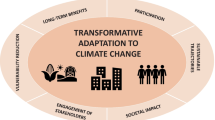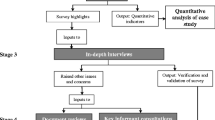Abstract
A variety of climate change adaptation support tools (CCASTs) have become available to support adaptation, but there is limited information about the types of tools available, their aims or their effectiveness. We reviewed the CCASTs currently in use, or in development, in Australia in order to identify those most used, the areas covered and the key knowledge gaps where development of new support tools is required. To ascertain the effectiveness of the CCASTs, we contacted CCAST developers/owners and logged evidence of uptake and/or evaluations already produced. We identified a total of 85 CCASTs, 65 in Australia and 20 selected international examples. Over half of the support tools identified in Australia were found to be associated with the infrastructure and planning and local government sectors. Biodiversity and business sectors offered the fewest CCASTs, 3 and 2 %, respectively. The majority of Australian CCASTs were developed at State and local government levels, presumably because adaptation tools are most applicable at local scales. Interestingly, the number of CCASTs showed a marked increase from 2007 onwards, with approximately 30 % of those recorded being currently in development. In Australia, the prevalent adaptation activity, and CCAST type, presently taking place is the identification and assessment of climate change risks. Knowledge gaps identified were for support tools providing guidance on: costing and prioritising adaptation options, evaluating and monitoring adaptation measures, conducting vulnerability assessments, facilitating adaptation for vulnerable species and ecosystems. Most organisations are at the early stages of adaptation: assessing climate risks and beginning to formulate adaptation options.


Similar content being viewed by others
References
Adger WN, Vincent K (2005) Uncertainty in adaptive capacity. CR Geosci 337:399–410
Adger WN, Arnell N, Tompkins E (2005) Successful adaptation to climate change across scales. Glob Env Change 15:77–86
Agrawala S, Fankhauser S (2008) Economic aspects of adaptation to climate change. Costs, benefits and policy instruments. Organisation for Economic Co-operation and Development (OECD), Paris
Australian Greenhouse Office (AGO) (2006) Climate change impacts and risk management: a guide for business and government. Australian Greenhouse Office, Canberra
Biesbroek GR, Klostermann JEM, Termeer CJAM, Kabat P (2013) On the nature of barriers to climate change adaptation. Reg Environ Chang. doi:10.1007/s10113-013-0421-y
Booth P (2011) Case studies of climate change adaptation tools and application processes in the local government sector. ACCARNSI—DRAFT Stage 1 Report, National Climate Change Adaptation Research Facility, Brisbane, Australia
Booth TH, Jovanovic T, Ho NS, Miller C (2013) A systematic regional approach for climate change adaptation to protect biodiversity. Clim Change 117:757–768
Boydell E (2010) Adaptation to climate change in practice: learning from a local government case study. Dissertation, Australian National University
Commonwealth Department of Climate Change (2010) Adapting to climate change in Australia: an Australian Government Position Paper. Department of Climate Change, Commonwealth of Australia, Canberra
Commonwealth Department of Climate Change and Energy Efficiency (DCCEE) (2011a) Review of the local adaptation pathways program. Department of Climate Change and Energy Efficiency, Canberra
Commonwealth Department of Climate Change and Energy Efficiency (DCCEE) (2011b) Local adaptation pathways program forum report: from risk to action. ICLEI, Canberra
Commonwealth Scientific and Industrial Research Organisation and Bureau of Meteorology (CSIRO & BoM) (2007) Climate Change in Australia: Technical Report 2007. CSIRO, Melbourne
Corney SP, Katzfey JJ, McGregor JL, Grose MR, Bennett JC, White CJ, Holz GK, Gaynor SM, Bindoff NL (2010) Climate futures for Tasmania: climate modelling technical report. Antarctic Climate & Ecosystems Cooperative Research Centre, Hobart, Australia
Dawson TP, Jackson ST, House JI, Prentice IC, Mace GM (2011) Beyond predictions: biodiversity conservation in a changing climate. Science 332:53–58
Department of Sustainability and Environment (DSE) (2008) Future Climate’ South Australian Government. http://www.climatechange.vic.gov.au/regional-projections. Accessed 23 March 2012
Department of Sustainability, Environment, Water, Population and Communities (DSEWPC) (2010) Australia’s biodiversity conservation strategy 2010-2030. National Biodiversity Strategy Review Task Group, Natural Resource Management Ministerial Council, Canberra
Dessai S, Lu X, Risbey J (2005) On the role of climate scenarios for adaptation planning. Glob Environ Chang 15:87–97
Hamden R (2012) Community led planning for the impacts of climate change. Oral presentation at climate adaptation in action 2012: sharing knowledge to adapt Conference, Melbourne, 26–28 June 2012
Heller N, Zavaleta E (2009) Biodiversity management in the face of climate change: a review of 22 years of recommendations. Biol Conserv 142:14–32
Hoegh-Guldberg O, Hughes L, McIntyre S, Lindenmayer DB, Parmesan C, Possingham HP, Thomas CD (2008) Assisted colonization and rapid climate change. Science 321:345–346
Indian Ocean Climate Initiative (IOCI) (2011) Publications. http://www.ioci.org.au/publications/cat_view/17-ioci-stage-3.html. Accessed 27 Feb 2012
Intergovernmental Panel on Climate Change (IPCC) (2001) Climate Change 2001: the scientific basis. In: Houghton JT, Ding Y, Griggs DJ, Noguer M, van der Linden PJ, Dai X, Maskell K, Johnson CA (eds) Contribution of Working Group I to the Third Assessment Report of the Intergovernmental Panel on Climate Change. Intergovernmental Panel on Climate Change, Geneva
Intergovernmental Panel on Climate Change (IPCC) (2007) Climate change 2007—impacts, adaptation and vulnerability In: Parry ML, Canziani OF, Palutikof JP, van der Linden PJ, Hanson CE (eds) Contribution of Working Group II to the Fourth Assessment Report of the International Panel on Climate Change. Cambridge University Press, Cambridge
International Council for Local Environmental Initiatives (ICLEI) (2008) Local government climate change adaptation toolkit. ICLEI Oceania, Victoria
Keating A, Handmer J (2011) Options for assessing the cost of climate change for adaptation policy in Victoria. Working Paper 2, Centre for Risk and Community Safety and VCCCAR, Victoria
Kuik OJ, Buchner B, Catenacci M, Goria A, Karakaya E, Tol R (2006) Methodological aspects of recent climate change damage cost studies. Working Papers FNU-122, Research Unit Sustainability and Global Change. Hamburg University, Hamburg
Lee C, Jacobs B, O’Toole D, Vines K (2012) Exploring the need for adaptation in government service provision to future climate through integrated regional vulnerability assessment (IRVA). Oral Presentation at Climate Adaptation in Action 2012 Sharing knowledge to adapt Conference, Melbourne, 26–28 June 2012
Local Government Association of South Australia (LGASA) (2012) Guidelines for undertaking an integrated climate change vulnerability assessment as part of developing an adaptation plan November 2012. http://www.lga.sa.gov.au/webdata/resources/files/Guidelines_for_Developing_a_Climate_Change_Adaptation_Plan.pdf. Accessed 10 May 2013
Local Government and Shires Association (LGSA) (2011) Climate Change action planning for local government workshop package. Local Government and Shires Associations, New South Wales
Mackey BG, Watson JEM, Hope G, Gilmore S (2008) Climate change, biodiversity conservation and the role of protected areas: an Australian perspective. Biodiversity 9:11–18
Mawdsley J (2011) Design of conservation strategies for climate adaptation. WIRES Clim Chang 2:498–515
Mawdsley J, O’Malley R, Ojima D (2009) A review of climate-change adaptation strategies for wildlife management and biodiversity conservation. Conserv Biol 23:1080–1089
Neilson C (2010) Climate adaptation tools for sustainable settlements report. Australian Institute of Landscape Architects. http://www.aila.org.au/climate/catss/docs/IFLA_AILA-CATSS-Report.pdf. Accessed 25 Feb 2012
Office of Environment and Heritage, New South Wales Government (2012a) Guide to integrated regional vulnerability assessment (IRVA) for climate change. http://www.environment.nsw.gov.au/resources/climatechange/130016IRVAguide.pdf. Accessed 10 May 2013
Office of Environment and Heritage, New South Wales Government (2012b) Integrated regional vulnerability assessment: South East New South Wales Pilot Study. http://www.environment.nsw.gov.au/resources/climatechange/IRVASthEastNSWVol1web.pdf. Accessed 10 May 2013
Parry M, Arnell N, Berry P, Dodman D, Fankhauser S, Hope C, Kovats S, Nicholls R, Satterthwaite D, Tiffin R, Wheeler T (2009) Assessing the costs of adaptation to climate change: a review of the UNFCCC and other recent estimates. International Institute for Environment and Development and Grantham Institute for Climate Change, London
Patt A, Klein R, de la Vega-Leinert A (2005) Taking the uncertainty in climate-change vulnerability assessment seriously. CR Geosci 337:411–424
Pittock AB, Jones RN (2000) Adaptation to what and why? Environ Monit Asst 61:9–35
Preston BL, Smith TF, Gorddard R, Measham TG, Withycombe G, McInnes K, Abbs D, Beveridge B, Morrison C (2008) Mapping climate change vulnerability in the Sydney Coastal Councils Group. Sydney Coastal Councils Group, NSW
Preston BL, Westaway RM, Yuen EJ (2011) Climate adaptation planning in practice: an evaluation of adaptation plans from three developed nations. Mitig Adapt Strateg Glob Chang 16:407–438
Prober SM, Thiele KR, Rundel PW, Yates CJ, Berry SL, Byrne M, Christidis L, Gosper CR, Grierson PF, Lemson K, Lyons T, Macfarlane C, O’Conner MH, Scott JK, Standish RJ, Stock WD, van Etten E, Wardell-Johnson G, Watson A (2012) Facilitating adaptation of biodiversity to climate change: a conceptual framework applied to the world’s largest Mediterranean-climate woodland. Clim Chang 110:227–248
Queensland Government (2009) Climate change impacts in Queensland’s regions. http://www.climatechange.qld.gov.au/climatechange/impactsinqueensland.html. Accessed 26 March 2012
SARDI (2010) Recent project reports. South Australian Research and Development Institute, South Australia. http://www.sardi.sa.gov.au/climate/publications. Accessed 23 March 2012
Serrao-Neumann F, Crick F, Harman B et al (2013) Improving cross-sectoral climate change adaptation for coastal settlements: insights from south-east Queensland, Australia. Reg Environ Chang. doi:10.1007/s10113-013-0442-6
Shoo LP, O’Mara J, Perhans K, Rhodes JR, Runting RK, Schmidt S, Traill LW, Weber LC, Wilson KA, Lovelock CE (2012) Moving beyond the conceptual: specificity in regional climate change adaptation actions for biodiversity in South East Queensland, Australia. Reg Environ Chang. doi:10.1007/s10113-012-0385-3
Smit B, Burton I, Klein R, Wandel J (2000) An anatomy of adaptation to climate change and variability. Clim Chang 45:223–251
Spearman M, McGray H (2011) Making adaptation count: concepts and options for monitoring and evaluation of climate change adaptation. World Resources Institute for the Federal Ministry of Cooperation and Development, Germany
Steffen W, Burbidge A, Hughes L, Kitching R, Lindenmeyer D, Musgrave W, Smith M, Werner P (2009) Australia’s biodiversity and climate change. CSIRO Publishing, Collingwood
Suppiah R, Preston B, Whetton PH, McInnes KL, Jones RN, Macadam I, Bathols J, Kirono D (2006) Climate change under enhanced greenhouse conditions in South Australia. CSIRO Marine and Atmospheric Research, Victoria, Australia
Taplin R, Henderson-Sellers A, Truek S, Mathew S, Weng H, Street M, Bradford W, Scott J, Davies P, Hayward L (2010) Economic evaluation of climate change adaptation strategies for local government: Ku-ring-gai Council Case Study. Bond University, Macquarie University and Ku-ring-gai Council
Weeks A, Sgro C, Young A, Frankham R, Mitchell N, Miller K, Byrne M, Coates D, Eldridge M, Sunnucks P, Breed M, James E, Hoffmann A (2011) Assessing the benefits and risks of translocations in changing environments: a genetic perspective. Evol Appl 4:709–725
Western Australian Local Government Association (WALGA) (2011) Climate change needs analysis survey 2011. Western Australian Local Government Association, Perth
Yuen E, Jovicich SS, Preston BL (2013) Climate change vulnerability assessments as catalysts for social learning: four case studies in south-eastern Australia. Mitig Adapt Strateg Glob Chang 18:567–590
Acknowledgments
The authors thank the Department of Environment and Conservation and Murdoch University for supporting the project through a Sustainability Internship by N. Aldum. Thanks to Shirene Hickman and Brett Crabtree for helpful discussions in the development of this review.
Author information
Authors and Affiliations
Corresponding author
Electronic supplementary material
Below is the link to the electronic supplementary material.
Rights and permissions
About this article
Cite this article
Aldum, N., Duggie, J. & Robson, B.J. Climate change adaptation support tools in Australia. Reg Environ Change 14, 401–411 (2014). https://doi.org/10.1007/s10113-013-0501-z
Received:
Accepted:
Published:
Issue Date:
DOI: https://doi.org/10.1007/s10113-013-0501-z




